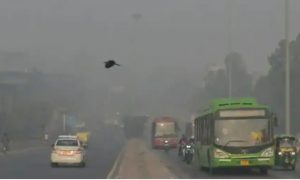A thick haze returned to Delhi on Tuesday amid stubble burning in neighbouring states, with official forecasters saying the air quality could hit “emergency” levels during the next two days because of low surface wind and cloud cover, sparking concerns by parents over schoolchildren being exposed to poisonous pollutants outdoors.
The Central Pollution Control Board’s (CPCB) 4pm bulletin on the Air Quality Index (AQI) on Tuesday showed the pollution was “severe” at 425, a sharp rise from 360 the previous day. By 11pm, the AQI had dipped to 449.
The 24-hour average concentration of PM2.5 ultra-fine particles reported by the Central Control Room for Air Quality Management-Delhi NCR’s dashboard breached the 300µg/m3 level regarded as the threshold beyond which the pollution is considered to be in the emergency zone.
The government’s air quality monitoring system, System of Air Quality and Weather Forecasting and Research (SAFAR), said winds blowing from the northwest carried plumes of smoke from burning stubble in Punjab and Haryana to New Delhi, causing the pollution to rise. “…The transport level wind direction is forecasted to be highly favourable for plume intrusion for the next two days,” it said.
“No sudden recovery is expected under this condition at least for the next two days and AQI is likely to deteriorate further towards SEVERE+ category by tomorrow (Wednesday). The condition may slightly improve by 15th November,” it added.
The agency said that while the farm fire count had gone down, the wind pattern was bringing in airborne particles that are harmful to human health.
The Aam Aadmi Party-led Delhi government said it restricted outdoor activities in schools, but there were no immediate plans of shutting down schools. The extension of road rationing measures, popularly called the odd-even scheme, will be reviewed on Wednesday after assessing the pollution over the next 24 hours, Delhi’s environment minister Kailash Gahlot said. The scheme was suspended on Monday and Tuesday for the 550th birth anniversary of Guru Nanak.
Authorities have faced criticism in the past over a delay in announcing a shutdown of schools over a technicality in the emergency action plan, even as experts say young children should be kept indoors till pollution levels ease.
On November 3, the AQI level hit 494, the worst since 2016, triggering widespread complaints from residents of burning eyes, itchy throats and shortness of breath. Days after the air emergency, the Supreme Court pulled up the Union government and the administrations of Punjab, Haryana and Uttar Pradesh for failing to stop farm fires. When informed that farm fires were lower in Haryana than Punjab, the judges summoned Punjab’s chief secretary and made stern remarks.
Farm fires result in heavy concentrations of PM2.5 ultrafine particles in the air, which can lead to major health problems since they can enter the bloodstream after penetrating deep into the lungs.
Weather experts said the national capital recorded a minimum temperature of 11.7 degrees Celsius, the season’s lowest so far, on Tuesday morning. It was two notches below normal for this time of the year. A dip in the wind speed and temperature makes the air cold and denser, leading to accumulation of pollutants.
CPCB data showed that all 38 monitoring stations across the city were in “severe” category on Tuesday. At 8pm, the average PM2.5 level was 332.8.
“The air quality is likely to deteriorate on Wednesday and reach upper end of severe category. The air quality is likely to deteriorate further on Thursday and may reach in severe plus category,” a bulletin by the union environment ministry said.
“Stubble burning fire points in Haryana, Punjab and neighbouring Pakistan were observed which is also contributing to deteriorating air quality,” it added.
As people reported of breathing difficulties on Tuesday, Environment Pollution (Prevention and Control) Authority (EPCA) member Sunita Narain said that the city was already in a “virtual shutdown mode”.
“The construction activities are banned, the industries are not operational, and there is massive efforts in force. Even though odd-even plan should have been in place today (Tuesday), at least it will be back tomorrow. Enforcement can be better but we need to now recognise how much more we need to do,” Narain said.
According to SAFAR, the share of stubble burning in Delhi’s air pollution on Tuesday was 25%. This was likely to reduce marginally on Wednesday to 22%.
Scientists at the India Meteorological Department (IMD) said layers of clouds shrouded the sun and the sunlight received was much less in comparison to the last few days.
“We have a double layer — of clouds and pollutants — in the atmosphere that has not allowed sunlight to reach the surface. Also shallow fog resulting in high moisture content during the morning hours added to making the air heavier, and thus increasing its capacity to trap pollutants. Besides, low wind speed too could not disperse pollutants,” said Kuldeep Srivastava, head, regional weather forecasting centre, IMD.




































